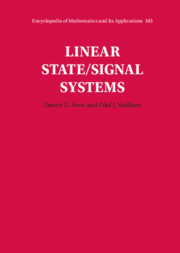Book contents
- Frontmatter
- Contents
- Preface
- Notations
- 1 Introduction and Overview
- 2 State/Signal Systems: Trajectories, Transformations, and Interconnections
- 3 State/Signal Systems: Dynamic and Frequency Domain Properties
- 4 Input/State/Output Representations
- 5 Input/State/Output Systems: Dynamic and Frequency Domain Properties
- 6 Bounded Input/State/Output Systems in Continuous and Discrete Time
- 7 Bounded Input/State/Output Systems in Continuous and Discrete Time
- 8 Semi-bounded Input/State/Output Systems
- 9 Semi-bounded State/Signal Systems
- 10 Resolvable Input/State/Output and State/Signal Nodes
- 11 Frequency Domain Input/State/Output Systems
- 12 Frequency Domain State/Signal Systems
- 13 Internally Well-Posed Systems
- 14 Well-Posed Input/State/Output Systems
- 15 Well-Posed State/Signal Systems
- Appendix A Operators and Analytic Vector Bundles in H-Spaces
- References
- Index
11 - Frequency Domain Input/State/Output Systems
Published online by Cambridge University Press: 05 May 2022
- Frontmatter
- Contents
- Preface
- Notations
- 1 Introduction and Overview
- 2 State/Signal Systems: Trajectories, Transformations, and Interconnections
- 3 State/Signal Systems: Dynamic and Frequency Domain Properties
- 4 Input/State/Output Representations
- 5 Input/State/Output Systems: Dynamic and Frequency Domain Properties
- 6 Bounded Input/State/Output Systems in Continuous and Discrete Time
- 7 Bounded Input/State/Output Systems in Continuous and Discrete Time
- 8 Semi-bounded Input/State/Output Systems
- 9 Semi-bounded State/Signal Systems
- 10 Resolvable Input/State/Output and State/Signal Nodes
- 11 Frequency Domain Input/State/Output Systems
- 12 Frequency Domain State/Signal Systems
- 13 Internally Well-Posed Systems
- 14 Well-Posed Input/State/Output Systems
- 15 Well-Posed State/Signal Systems
- Appendix A Operators and Analytic Vector Bundles in H-Spaces
- References
- Index
Summary
In Chapter 5, we defined various dynamic time domain notions for i/s/o systems, such as reachable and unobservable subspaces, controllability and observability, strong and unobservable invariance, external equivalence, intertwinements, compressions, dilations, restrictions, extensions, and projections. Here, we present frequency domain counterparts of these definitions. One of the four components of a frequency domain trajectory is a constant representing an “initial state,” and the other three components are analytic functions defined on some open subset Ω of the complex plane, representing a “frequency domain state,” a “frequency domain input,” and a “frequency domain output.” By the frequency domain i/s/o system induced by an i/s/o node Σ, we mean the node Σ itself together with the set of all frequency domain trajectories. Some of our frequency domain definitions can be applied to arbitrary i/s/o nodes, but most of the time we assume that Σ is resolvable and that the set Ω on which the trajectories are defined is contained in the resolvent set of Σ.
- Type
- Chapter
- Information
- Linear State/Signal Systems , pp. 679 - 742Publisher: Cambridge University PressPrint publication year: 2022

